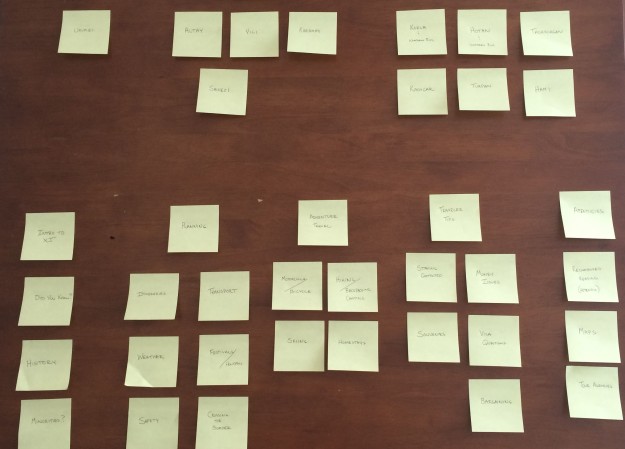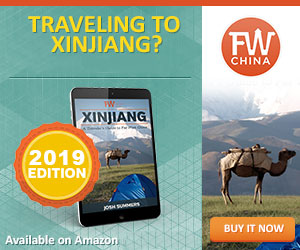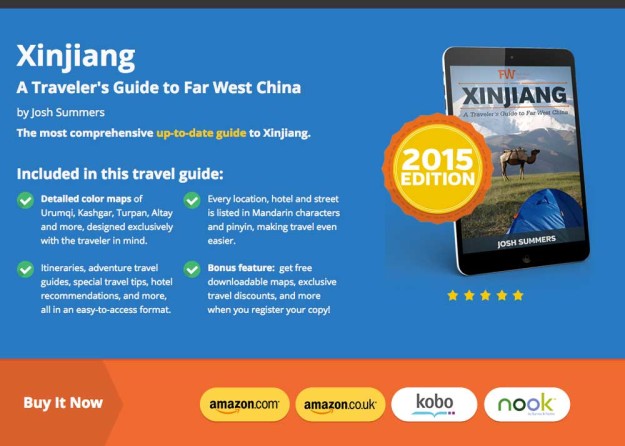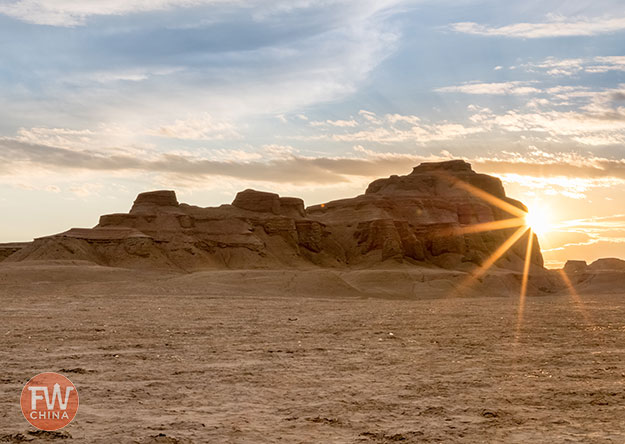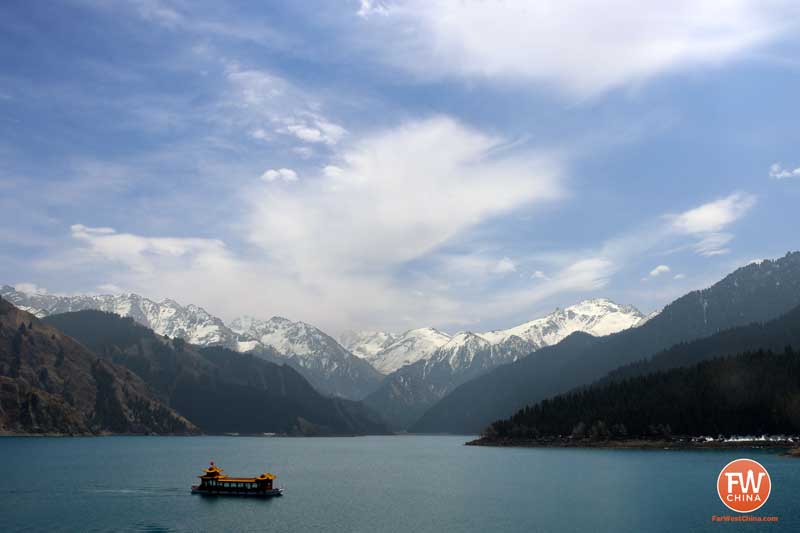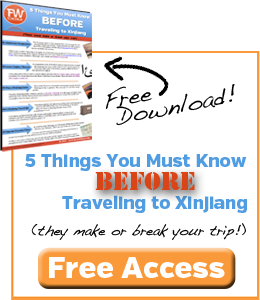Self-Publishing a Travel Guide: My Experience
In 2014, I published my first Kindle travel guide on Amazon. I’ve since published other books and even turned this travel guide into a print book. Hopefully you can learn a bit about the self-publishing process through my successes and mistakes!
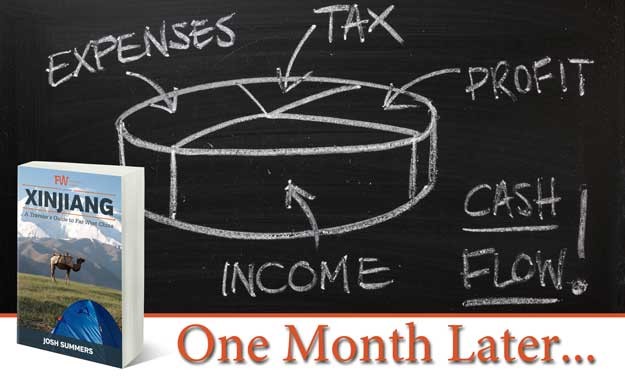
It’s been just over a month almost 5 years since the FarWestChina Xinjiang travel guide was published. It wasn’t easy, but I’m glad I did it.
I thought it would be interesting to review the process and share the numbers thus far – both income and expenses. It’s been a learning process for me and hopefully others can benefit from my experience.
Let me begin by saying that FarWestChina has never been a huge money-making website for me. Thanks to a few advertisements and limited affiliate sales every month, the website more than covers its costs, although not by much more.
I’ve always known that the Xinjiang travel niche is a small one, so the ceiling for advertising and affiliate sales is painfully low.
FarWestChina will always be a labor of love, to be sure, but self-publishing my own regional travel guide was a dream.
The Process: Self-Publishing a Travel Guide
The decision to write a Xinjiang travel book was not taken lightly. At first glance, it doesn’t seem prudent to start treading on the turf of heavyweights like Lonely Planet, DK, Odyssey and many others.
Obstacle: There’s already a lot of competition…why should I publish my own?
I have worked with Lonely Planet and DK in the past as a fact-checker so I am intimately familiar with the quality and detail they provide.
However, I also knew there was a lot missing when it came to Xinjiang.
I remember sitting down at an empty table in February of 2014 with a pen and some sticky notes. I had put this off for years and now I finally decided to put together the skeleton bones of the book.
Writing a Travel Guide Isn’t Easy
At this point, the entire writing process took me two months – a whole month longer than I had anticipated.
That was my lesson #1: writing a book is harder than writing a blog and requires much more time and dedication.
Looking back, I should have started this process much earlier…”
Looking back, I should have started this process much earlier, perhaps as early as November or December of last year.
Because I chose to self-publish, I not only had to write the book; I also had to:
- Arrange for cover design;
- Develop map designs;
- Communicate with contributing writers;
- Arrange for an editor;
- Set up a marketing plan;
- …and more.
A bit ambitious, I now admit.
My goal was to publish before the May holiday travel season, and back in February I thought I had plenty of time. Oh, how wrong I was.
The process of writing the book was done using Scrivener, a program designed for writers. The decision to use Scrivener didn’t seem important when I first started writing, but I now realize it was an indispensable tool.
Not only did it help organize my research and writing; when it came time to publish, Scrivener made it easy to format the book for both digital and print publication.
That ended up being lesson #2 for me.
Choosing a great writing and publishing tool was about as important as choosing the right designer and editor.
I could have used Microsoft Word, but in the end, using Scrivener probably saved me days of work formatting the book for publication.
The Cost: Designing a Travel Guide
Instead of blabbering on, I’ll go ahead and just list out my initial costs related to the creation of the FarWestChina Xinjiang travel guide:
Here’s my lesson #3.
Design work will cost 5x-10x’s more than you expect.
Could I have found cheaper designers? For the cover, definitely. I’m not sure about the maps. In both cases, though, I was working with designers that I knew personally and trusted. To me, it was definitely worth the expense.
At the time, I was expecting to sell the Xinjiang travel guide for $19.99, which means that I would need to sell approximately 177 copies of the book to break even. The math looked like this:
Initial calculations for break even:

Of course, this doesn’t take into account any advertising I wanted to do.
The first month I ended up trying out advertising on two different platforms: Google Adsense and Facebook Ads. I spent about $150 on each platform and honestly, neither were as effective as Amazon ads have been.
I’m getting a little ahead of myself on the advertising, though, because before I even published the book I ran into a HUGE setback that hit me like a ton of bricks.
Unexpected Curveball: Amazon
For those who have published on Amazon before, you might already know what I’m about to say. Honestly, I feel stupid for not having realized this earlier.
My readers would pay double the price and the only party that would benefit would be Amazon.”
It happened while I was uploading my .epub file to Amazon. When I got to the point in the process where I could set my pricing, Amazon informed me of a simple fact that completely changed my game plan:
Amazon caps ebook pricing at $9.99 if you want to get 70% royalties. Anything higher than $9.99 drops royalties to 35%.
Ouch.
In other words, whether I sold the book for $9.99 or $19.99, the royalties I received for each book would be exactly the same. My readers would pay double the price and the only party that would benefit would be Amazon.
I made the hard decision to lower my price to $9.99, immediately doubling my break-even calculations.
Final calculations for break even:

Value Perception versus Amazon Reviews
The trouble with selling for $9.99 goes beyond finances, though. I now have to deal with value perception.
When compared to other books by major publishers (Lonely Planet, Odyssey, etc.), all of which are priced above $20, the $9.99 FarWestChina book looks inferior in value.
The way I eventually made up for that was through reviews. It took time, though, and required a strategy of creating bonus content that required readers to give me their email address.
I used this email address to thank them for buying the book, give them the bonus materials, and then a week or two later…
…politely ask for a review.
Even though I believe that this travel guide is twice as detailed as any other book on the market, I had to sell it for half the price. Reviews and proper marketing had become more important than ever.
Click “Publish” and…Sell?
I decided early on that I would initially publish only on digital format, and to this end chose what I believe to be the three largest digital book platforms: Amazon Kindle, Kobo, and Nook.
Each was given equal treatment on my first sales page, which you can see below:
After a month of promotion and sales, however, it’s obvious which platform performed the best (and which wasn’t worth the effort at all).
| Platform | Copies Sold | Revenue |
|---|---|---|
| Amazon Kindle | 115 | $783 |
| Kobo | 7 | $49 |
| Nook | 1 | $6.50 |
| Total: | 123 | $838 |
Thankfully, I spent no more than 20 minutes formatting and uploading the book to Nook so I wasn’t too disappointed there.
The release of the book was marketed, as most of you know, primarily through Facebook, Twitter and my email list.
As expected, many travelers bought within the first week thanks to a special promotion, resulting in a spike in sales followed by a return to equilibrium.
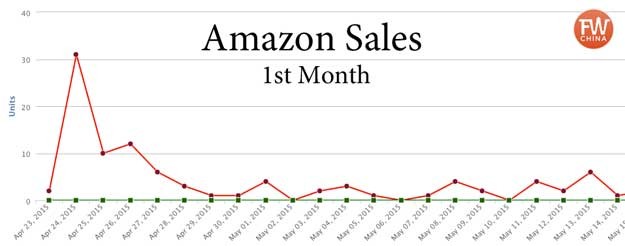
The spike in sales resulted in an immediate jump to the top of Amazon’s bestseller list in both the China and India categories, where I’m proud to say it stayed for about 10 days.
Reviews began to slowly trickle in, which I am extremely grateful for.
Within just a week of release, the FarWestChina Xinjiang travel guide had more reviews than any other Xinjiang-related book on Amazon. Not only am I grateful for the reviews, but I’m also extremely happy with the quality of reviews – my readers have gone above and beyond in this regard!
Here are a few of my favorite quotes:
Reading this guide, to me, is no different than sitting down and chatting with your buddy and getting the real DL and getting all of your questions answered in a casual and entertaining atmosphere.”
Even if you know nothing about Xinjiang, after reading this book, you will want to visit and the book will take you step by step around the area.”
I’ve traveled to Xinjiang before, and not only did this guide square with my experiences in the places I visited, it added a lot of information that I wish I’d known at the time.”
Read the AWESOME reviews on Amazon here
For those of you who left a review of the book on Amazon or Kobo…THANK YOU. The importance of reviews cannot be overstated, particularly for a self-published title.
In addition to book sales, I also should mention the fact that I sold half-page advertising within the book to travel agencies here in Xinjiang.
Because I was asking these agencies to take a chance on a book whose sales I couldn’t guarantee during a time when Xinjiang travel is quite slow, I decided on an extremely discounted price of $100 per ad for the 2015 edition.
In-Book Advertising: $100 x 3 Advertisers = $300
I realize I could have easily commanded a higher rate but I decided not to for two reasons:
- My desire is to benefit Xinjiang travel agencies, not make money off them and
- I needed a few ads to test in this edition so I can provide better statistics for possible advertisers in the 2016 edition.
There are a few affiliate links within the book for hotels and travel services but it will be a few months before I can accurately track whether these links are both beneficial to the reader and profitable for me.
So overall, including sales and advertising, this is the breakdown of income vs expenses this first month:
Income vs. Expense | 1st Month Simple Breakdown
| Book Sales: | $838 | Upfront Costs: | $2,477 | |
|---|---|---|---|---|
| Advertising Sales: | $300 | Advertising: | $300 | |
| Total Income: | $1,138 | Total Expenses: | $2,777 |
5 Years Later – An Update
It’s now been 5 years since my Xinjiang travel guide was released and a lot has changed.
The most important change was the addition of the print version of the guide, which I released in 2019. Why did it take so long?
Honestly, it was much harder than I thought it would be.
I had to pay somebody to help me with the layout ($200) and then another designer to create a print cover that included both the spine and back ($300).
I’m using Amazon’s print on demand service, which although more expensive, allows me to serve readers all across the world and not have to deal with shipping and inventory.
The Numbers Don’t Lie
As of April 2020, which is 5 years after I initially self-published the book, here’s where I stand:
| Book Unit Sales | Royalties | |
|---|---|---|
| Kindle eBook | 1,026 | US$4,875 |
| Print Version | 62 | US$352 |
I’m not including sales from Kobo and Nook here because I eventually removed the book from those platforms in order to get the benefits of Kindle exclusivity (which, in hindsight, doesn’t seem worth it to me).
A few things to note here:
- Yes, I did recoup my costs, but it wasn’t a runaway money-maker for me;
- That said, the credibility that comes with having my own travel guide was worth far more than the royalties;
- The book continues to sell, although at a much slower rate than before;
- I have done updates to the book each year.
The biggest thing working against me here was, again, the very small niche I’m working in. Very few people travel to Xinjiang.
Thankfully, I was able to take what I learned here to publish other books that are geared toward a bigger audience and have been far more profitable.
Final Thoughts on Self-Publishing
If you’re interested to self-publish your own guide, I highly recommend you give it a try. It’s easier than you might think, at least for an ebook.
And you don’t have to create a 200+ page book like I did. Selling a shorter guide for between $0.99 and $4.99 tends to work much better than what I did.
And yes, you have to play the Amazon game because they control the market.
But that doesn’t mean you can’t sell your own copies or distribute through other channels. It’s just more work on your part.
Good luck!

